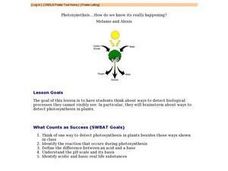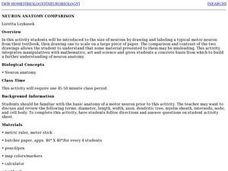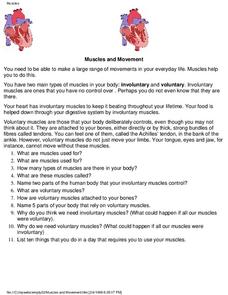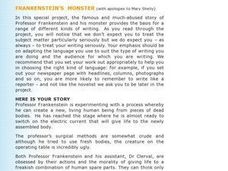Curated OER
Measurable You!
Conduct guided experiments and discussions while collecting anthropometric measurements. Your class will explore impact of experimental errors in a scientific system, and explain their observations/findings in writing. An introduction to...
Curated OER
Photosynethsis....How do we know it's really happening? - Biology Teaching Thesis
Students think of one way to detect photosynthesis in plants besides those ways shown in class. They identify the reaction that occurs during photosynthesis. Students define the difference between an acid and a base. They identify acidic...
Howard Hughes Medical Institute
Central Dogma and Genetic Medicine
Scientists work every day to find solutions to genetic diseases. Scholars learn about the process of gene sequencing, mutations, and the results. They explore genetic diseases and therapies to intervene and help and, through case...
Curated OER
Hazards: Second Grade Lesson Plans and Activities
Equip learners with safety knowledge in the case of an earthquake. After coloring the places to go to get help after a quake, and label places that wouldn't be safe to go after a quake, young geologists simulate three levels of...
University of Minnesota
Sheep Brain Dissection
Bored with frog and earthworm dissections? Had your fill of fetal pigs? Anatomy students will be intrigued by the sheep's brain, and you will be prepared with guiding questions, extension activities, and pictures as they dissect one —...
American Institute of Architects
Architecture: It's Elementary!—First Grade
Build an interest and appreciation for architecture in your young learners with this fun 10-lesson art unit. Engaging children in using their five senses, the class first observes the environment around them, paying special attention to...
Shmoop
ELA.CCSS.ELA-Literacy.RL.9-10.9
As the saying goes: there are no new stories. Standard 9 for reading literature in the Common Core addresses this fact and requires that students be able to analyze how authors use the themes, stories, and characters of earlier works....
University of Minnesota
Neurotransmission Model
Don't lose your marbles — you'll need them for a lesson on neurotransmission. Young scholars build a neurotransmission model using marbles, beads, rubber bands, string, and other elements. After studying specific neurotransmitters,...
Cornell University
Atomic Bonding
Explore the connection of surface area to bonding within atoms. Learners complete lab investigations to model changing surface area with different sizes and concentrations of atoms. A flour fireball demonstration follows the labs to...
Curated OER
Organizing Organs
Fifth graders research plant and animals cells and create a Venn Diagram to show the similarities and differences.
Curated OER
Water 1: Water and Ice
Learners explore the water cycle. In this water cycle lesson plan, students complete a hands-on activity that replicates the water cycle. Learners record their observations.
Curated OER
Heart 1: Transplant
Pupils explain the workings and anatomy of the heart and to explore new medical techniques that help people live longer, healthier lives.
Curated OER
Broken Bones
Learners listen to a lecture on broken bones. They review the proper first aid techniques and practice setting splints on one another. They observe X-rays and animal bones.
Curated OER
Heart 2: Changing Lifestyles and Heart Health
Students examine and evaluate changes in diet and lifestyle from prehistoric to modern times and how these differences have spurred the development (and better treatment) of heart disease.
Curated OER
Avoiding Sports Injuries
Students research sports injuries and how to deal with the injury. In this injury prevention lesson, the teacher introduces several exercise risk factors and prevention techniques, then students work in small groups to conduct research...
Curated OER
Sorting
Pupils study how things are stored and how information is retrieved. In this investigative lesson students play a game that helps them to see how things are sorted in a library.
Curated OER
Neuron Anatomy Comparison
Learners create a scale model of a motor neuron that is two hundred times larger than the actual neuron. They identify the structures of a neuron and observe neurons under the microscope then use a worksheet to convert actual sizes into...
Curated OER
Synonyms
For this synonyms worksheet, learners read 9 words in a box. Students choose four words and find as many synonyms as possible, writing them on another piece of paper in the form of a brainstorm.
Curated OER
Jumpy Dolls
Learners are challenged to design and construct a jointed figure that moves in a motion something like jumping jacks when a string is pulled.
Curated OER
Shells
Sixth graders label diagrams of the 6 different classes of mollusks and explain the meaning of the labeled terms. They identify 8 common New Haven shells. They organize their own shell collection during this series of lessons.
Curated OER
Five Senses - Learning With The Senses
Students name the five senses, compare learning with and without the senses.
Curated OER
My Beating Heart
Students watch a video over the functions of the heart. They follow along on a website to see how the heart pumps blood.
Curated OER
Frankenstein's Monster
Students read Mary Shelly's Frankenstein. Using situation and question prompts, students write various essays, letters, and articles concerning the events in the story from different character's point of view.
Curated OER
Paper Puppet
Students create hand puppets using basic art supplies, paper cups, cotton balls, and yarn in this 1st and 2nd grade Art lesson plan. Emphasis is placed on the history of puppets and puppetry. The lesson plan includes a short vocabulary...
Other popular searches
- Human Body Parts Pictures
- Spanish Human Body Parts
- Human Body Parts Edible
- Human Body Parts Bingo
- Main Human Body Parts
- The Human Body Parts
- Human Body Parts Photographs
- Human Body Parts Worksheet
- Pics Human Body Parts
- Human Body Parts Names
- Human Body Parts Poster
- Parts of the Human Body

























